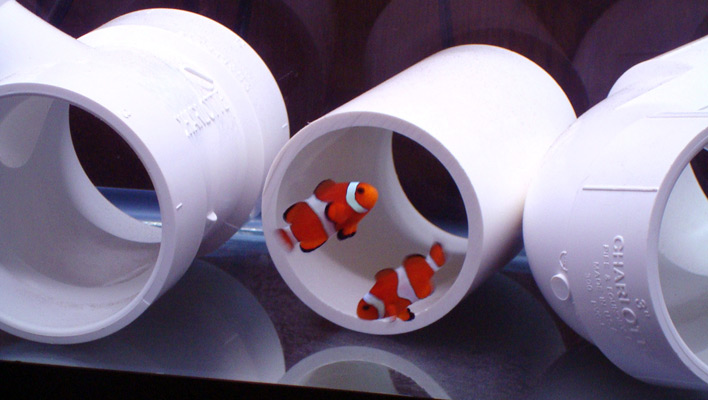For most of my years as a saltwater aquarium hobbyist, I’ve made a point of quarantining all new fish before introducing them to my main system. By and large, my approach to the quarantine process has been observational—that is, watching specimens closely for signs of disease and treating them only if symptoms appear in order to avoid stressing them unnecessarily. However, (relatively) recent events have me questioning whether I’d be better advised to treat all quarantined specimens prophylactically rather than wait for symptoms to arise.
Allow me to set the stage: A few years ago, my wife, Melissa, and I sold our old home and moved into a smaller one after an intervening year in a rented duplex. Naturally, once we got settled in, I took the first opportunity to set up my old 125-gallon tank, which had been in storage throughout the transition. Once I got the system up and running and began to cycle it, I set up a 29-gallon quarantine tank and acquired three specimens—a yellow tang, Niger trigger, and coral beauty. My plan was that these three would be the tank’s only fishy inhabitants (at least initially) along with a percula clownfish that I’ve had since 1997. Each was given a five-minute freshwater dip and then placed in quarantine.
After some minor initial squabbling, the three settled down and cohabited peacefully, took to eating standard aquarium fare reasonably quickly, and generally appeared to be in good health. A week passed with no problems, then two weeks, then three. At four weeks, they still showed no worrisome symptoms and I was tempted to introduce them to the display tank, yet I thought it best to keep them in quarantine for at least one more week just to be on the safe side.
Once about five and a half weeks had lapsed with no sign of disease, I decided it was safe to transfer the new specimens along with my old clownfish (which had been housed in a five-gallon tank at my in-laws’ house throughout our move) to the display. This process also went relatively smoothly, again with only minor disputes among the specimens as they claimed their territories.
Another quarantine period had come to a successful conclusion. Or so I thought.
About a week later, the yellow tang began to exhibit a classic sign of parasitic infection—scraping its body on the rockwork. First spotting this out of the corner of my eye, I thought perhaps I’d imagined it, but Melissa confirmed she’d seen it too. Over the next few days, the problem became unmistakable. The tang was scraping with increasing frequency, and the other specimens were starting to scrape as well. I also noticed a few tell-tale white spots on the tang, suggesting the culprit was likely the protozoan Cryptocaryon irritans.
So back into the quarantine tank they all went for treatment (along with the clownfish, which I now had to assume was also infected). I was fortunate in that the display tank housed no corals or other sessile invertebrates yet, so netting out the fish was fairly easy, and that I hadn’t exposed an established population of fish to disease (the clownfish notwithstanding).
Fortunately, a few courses of Cupramine proved effective in curing the sick specimens, so after an appropriate interval to verify that they were indeed symptom-free, I returned them to the display tank. They have been fine ever since. Things definitely could have turned out much worse, but I was scratching my head over how I’d managed to overlook this problem in the first place.
Would I have eventually noticed symptoms if I’d kept the fish in quarantine for just a few more days, bringing the total to a full six weeks? Possibly. Then again, the first obvious signs didn’t appear until a week after they’d been moved to the display tank—a total of six and a half weeks after starting them in quarantine.
I also wondered whether the fish were manifesting symptoms while still in quarantine but I simply wasn’t paying close enough attention to notice them. This didn’t seem very likely since the QT was situated right behind the desk in my home office and would draw my attention (and distract me from work) quite frequently.
Another thing to consider is that there are different strains of Cryptocaryon and that the duration of the various stages of this parasite’s life cycle can vary depending on temperature and other factors.
However, I suspect the most likely explanation is related to how I typically manage water quality in a quarantine tank. To avoid ammonia spikes in these temporary systems, I usually perform relatively large water changes on a frequent basis. Perhaps in doing so I was siphoning out just enough of the free-swimming, infective theronts to limit any infection to a subclinical level. Then once I moved the “healthy” specimens to the display tank and a little more time had passed, the parasites had more opportunity to reproduce and make their presence known.
Whatever the explanation, it occurs to me that beginning prophylactic treatment for common parasites right after introducing specimens to quarantine (assuming the species in question are known to tolerate the treatment) might be a good way to avoid a similar—and potentially much more disastrous—problem in the future. Of course, that would require a change in philosophy on my part, as I’ve always felt strongly that medications should be treated as an option of last resort. But after this experience, I’m definitely reconsidering my long-held position on strictly observational quarantine.
How about you, fellow salties? What’s your take on proactive versus reactive treatment in quarantine? What has worked for you and what hasn’t? Please let us know in the comments section below.



